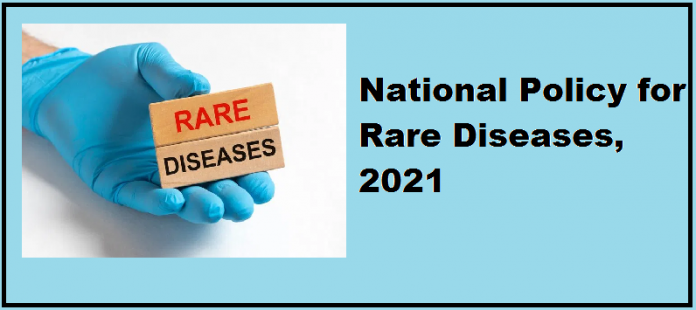Hello Learners!
Hope you all are safe and doing well.
In today’s article, we will look at the “National Policy for Rare Diseases, 2021” which was recently approved by the Ministry of Health and Family Welfare. We will discuss the aim, provisions and other major points of this policy. But before looking at the policy, let us first study about Rare Diseases. We will also learn about Rare Diseases in India and challenges associated with them.
Table of Contents
What are Rare Diseases?
A disease that affects a smaller percentage of the population compared to other diseases is a rare disease. According to the World Health Organization, rare diseases are those diseases with a prevalence of 1 or less per thousand population. However, several other countries use their own definitions. For example, the definition accepted in the United States is that it is a disease that afflicts fewer than 2,00,000 people. EU defines rare diseases as a life-threatening or chronically debilitating
condition affecting no more than 5 in 10,000 people. Broadly, a ‘rare disease’ is a health condition of low prevalence. It affects a small number of people when compared with other prevalent diseases in the general population.
Rare Diseases in India
- 56-72 million Indians are affected by rare diseases. Globally, there are around 7000 – 8000 rare diseases, out of which 450 rare diseases have been recorded in India.
- Some of the common rare disease affecting people in India are auto-immune diseases which include:
- Primary immunodeficiency disorders
- Lysosomal storage disorders (Gaucher’s disease, Pompe disease, Mucopolysaccharidoses, fabry disease etc.)
- Small molecule inborn errors of metabolism (Maple Syrup urine disease, organic acidemias, etc.)
- Cystic Fibrosis
- Osteogenesis imperfecta,
- Certain forms of muscular dystrophies and spinal muscular atrophy, etc.
- There are higher incidences of rare diseases in India. The reason put forth by experts is the practice of consanguineous marriages in some communities. The most common rare diseases in India are Lysosomal Storage Disorders (LSD).
Issue and Challenges associated with Rare Diseases
- The field of rare diseases is very complex and heterogeneous and prevention, treatment and management of rare diseases has multiple challenges.
- There is a lack of awareness about rare diseases in the general public as well as in the medical fraternity.
- Early diagnosis of rare diseases is a major challenge due to lack of adequate screening and diagnostic facilities.
- There are also challenges in the research and development of rare diseases. Very little is known about the pathophysiology of rare diseases. Rare diseases are also difficult to research upon as the patient pool is very small and it often results in inadequate clinical experience.
- Limited availability and accessibility to medicines.
- The cost of treatment of rare diseases is prohibitively expensive.
Fig: Issues & Challenges associated with Rare Diseases
Aim of National Policy for Rare Diseases 2021
To address all these challenges, the Ministry of Health and Family Welfare came up with a very comprehensive National Policy for Rare Diseases 2021. Let’s look at the aim and key features of this policy.
- It aims at lowering the incidence and prevalence of rare diseases based on an integrated and comprehensive preventive strategy.
- To increase focus on research and development and local production of medicines.
- To lower the high cost of treatment for rare diseases.
- Focus on early screening and prevention through primary and secondary health care infrastructure.
Key Features of National Policy for Rare Diseases 2021
- The policy has categorised rare diseases into three groups:
- 1st Group: Disorders amenable to one-time curative treatment.
- 2nd Group: Those requiring long term or lifelong treatment.
- 3rd Group: Diseases for which definitive treatment is available but challenges are to make an optimal patient selection for benefit, very high cost and lifelong therapy.
Key Features:
- It proposed to have a National Registry for a database of rare diseases. This will ensure that adequate data and comprehensive definitions of such diseases are available for research and development purposes.
- Early screening and prevention of rare diseases would be achieved through Health and Wellness Centres. The screening is to be supported by the Nidhan Kendras set up by the Department of Biotechnology.
- 8 health facilities are to be designated as Centres of Excellence of rare diseases. They will focus on the prevention and treatment of rare diseases. These centres are to be provided with the one-time financial support of Rs 5 crores.
- A provision for financial support up to Rs. 20 lakhs under the Umbrella Scheme of Rashtriya Arogya Nidhi. It is proposed for treatment of those rare diseases that require a one-time treatment (diseases listed under Group 1).
- It also proposed a crowdfunding mechanism for voluntary contribution through a digital platform. Through this, corporates and individuals will be encouraged to extend financial support for the treatment of rare diseases.
Some Extra Facts about Rare Diseases
- Rare Disease Day is observed on February 28 every year.
- Rare diseases are also known as ‘orphan diseases’. They acquired this name because pharmaceutical companies feel reluctant to develop drugs for them due to their low prevalence. Orphan drugs are drugs used to treat rare diseases.
So this was all about the National Policy for Rare Diseases 2021. In this article, we have covered all the important information related to this policy. Hope you enjoyed reading it. For more such detailed articles, stay tuned!
Thank you




